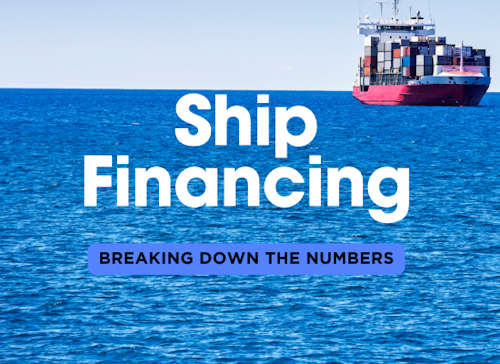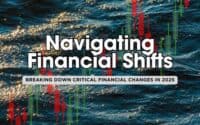Breaking Down the Numbers: Ship Financing Explained

- Methods of Ship Financing
- Understanding Average Industry Rates
- Tax Considerations in Ship Financing
- Creative Ways to Finance in the Shipping Industry
- Key Financial Metrics in Ship Financing
Financing is one of the mechanisms that transforms ambitions into tangible vessels, facilitating global trade and commerce. With the maritime landscape more intricate than ever, understanding the multifaceted world of ship financing is paramount for industry players to navigate these financial waters successfully. Let's break it down!
| ShipUniverse: Ship Financing Solutions | |||||
|---|---|---|---|---|---|
| Financing Option | Pros | Cons | Interest Rate Range | Loan Amount | Typical Repayment Period |
| Bank Loan | - Low interest rates - Established process - Large loan amounts |
- Lengthy approval process - Requires strong credit - Collateral often needed |
3% - 6% | $500,000 - $50 million | 5 - 20 years |
| Leasing | - Lower upfront cost - Easier approval process - Maintains capital flexibility |
- Higher long-term cost - Less ownership control - Maintenance obligations |
4% - 8% | $250,000 - $30 million | 5 - 15 years |
| Private Equity | - Large amounts available - Flexibility in terms - No need for collateral |
- Higher interest rates - Potential for loss of equity - May require giving up some control |
8% - 15% | $5 million - $100 million | 5 - 10 years |
| Export Credit Financing | - Government-backed - Long repayment periods - Low interest rates |
- Limited to certain countries - Lengthy approval process - May require specific criteria |
2% - 4% | $10 million - $100 million | 10 - 25 years |
| Bridge Financing | - Quick access to funds - Short-term flexibility - No long-term commitment |
- High interest rates - Short repayment period - Risk of default if refinancing fails |
10% - 18% | $100,000 - $10 million | 6 months - 2 years |
| Shipbuilder Financing | - Specialized in maritime assets - Easier to negotiate flexible terms - Could bundle with shipbuilding contracts |
- Limited financing options - Higher down payment needed - Restricted to specific shipbuilders |
4% - 7% | $5 million - $100 million | 5 - 15 years |
| Mezzanine Financing | - Flexible financing option - No collateral needed - Suitable for large projects |
- Higher risk due to interest rates - Potential for partial ownership dilution - Shorter terms |
10% - 20% | $10 million - $150 million | 3 - 10 years |
| Sale-Leaseback | - Frees up capital - Retain operational control of the ship - Tax advantages possible |
- No longer own the ship - Lease payments could exceed ownership costs - Financial risk if resale values drop |
6% - 10% | $1 million - $50 million | 5 - 15 years |
| Joint Ventures | - Share financial risk - Access to more capital - Expertise from other stakeholders |
- Loss of full ownership - Profits shared with partners - More complex decision-making |
5% - 12% | $10 million - $200 million | Varies |
| Syndicated Loan | - Suitable for large transactions - Shared risk among lenders - Flexible loan structure |
- Complex agreements - Longer negotiation process - Interest rate may be higher due to risk |
4% - 9% | $50 million - $500 million | 5 - 20 years |
Insider Tips
🚢 Start with specialized maritime lenders
Instead of going to a general bank, focus on lenders who specialize in maritime assets. They understand the complexities of ship financing, from maintenance to depreciation, and offer terms tailored for ship purchases.
🏦 Negotiate for a flexible repayment structure
Cash flow can be unpredictable in the shipping industry. Ask for a repayment structure that aligns with your operational revenue, such as seasonal adjustments or balloon payments at the end of the loan.
📊 Leverage historical data to secure better terms
Present lenders with a solid track record of your fleet’s performance. Use data like fuel efficiency, route profitability, and vessel uptime to demonstrate low operational risk and secure lower interest rates.
💸 Consider co-financing with international partners
For large acquisitions, explore co-financing with partners from regions that have favorable lending rates, such as Asia or Scandinavia. This can diversify financial risk and give you access to lower-cost capital.
🛠 Shipyard financing can lower costs
Some shipbuilders offer in-house financing. If you’re planning to purchase new, look for shipyards that bundle financing with shipbuilding. This can lower overall costs and streamline the purchase process.
🌍 Use export credit agencies for international purchases
If you're buying a ship from overseas, look into Export Credit Agencies (ECAs) that back loans for ships built in their country. These agencies often provide favorable terms to encourage international sales.
📈 Look for fixed-rate loans during market volatility
Interest rates fluctuate, especially in global markets. Lock in a fixed rate when interest rates are low to protect against unexpected hikes, ensuring predictable payments over the loan's life.
🤝 Build relationships with private equity investors
Don’t overlook private equity as a financing solution. Investors who focus on maritime assets can provide capital with more flexible terms, especially if you’re looking to expand or upgrade a fleet.
💼 Opt for sale-leaseback to free up capital
If you need to raise funds quickly, consider selling a vessel and leasing it back. This keeps the ship in operation while freeing up cash for other investments, like expanding routes or upgrading technology.
📅 Take advantage of balloon payments
Many maritime loans offer balloon payments, where a large portion of the loan is paid at the end of the term. This can help keep your monthly payments low while you focus on growing your shipping business.
1. Methods of Ship Financing
a. Traditional Bank Loans - At the core of ship financing are traditional bank loans, where financial institutions offer loans to cover ship acquisition or operational costs. The borrower pledges the ship as collateral, ensuring the bank can reclaim the vessel if the loan isn't repaid. - Major global banks, many with specialized maritime financing departments, dominate this sphere. Their expertise and global networks make them invaluable to shipowners seeking funds.
Get Competitive Maritime Financing Quotes Todayb. Leasing - Leases fall into two main categories: Operating leases, where the lessor owns the vessel and the lessee rents it for a period, and financial leases, which are more like rent-to-own schemes. - Leasing provides flexibility. Operating leases can keep assets off a company's balance sheet, aiding financial metrics, while financial leases offer a pathway to ownership without an upfront purchase.
c. Public Equity and Debt - As shipping companies grow, they might consider going public, launching an Initial Public Offering (IPO) to raise capital. This not only provides funds but can also elevate a company's profile and credibility. - Bond issuance is another avenue. Companies can issue bonds, essentially IOUs, promising to repay investors with interest. They're a way to raise large sums without diluting company ownership.
d. Private Equity - Venture capitalists and private equity firms invest in companies in exchange for a stake in the business. They typically look for high-growth opportunities and can offer not only funds but also expertise and connections. - Private equity can be an attractive option for shipowners seeking substantial investments, especially if they're open to external guidance or if traditional financing routes aren't viable.
e. Joint Ventures and Partnerships - Sometimes, the sheer scale of a project or the strategic benefits necessitate pooling resources. Joint ventures allow multiple entities to come together, sharing both the costs and the rewards. - Numerous case studies spotlight the success of joint ventures in ship acquisition, showing the strength of collaboration in accessing funds, sharing risks, and maximizing opportunities.
2. Understanding Average Industry Rates
Navigating the waters of ship financing means understanding the underlying currents that determine interest rates and financing costs. These rates aren't static; they ebb and flow in response to a myriad of factors, both global and industry-specific.
a. Factors Influencing Rates
- Global Economic Conditions: Just as the tide affects every ship in the harbor, global economic conditions have a sweeping influence on financing rates. Economic booms may make credit more accessible and potentially cheaper, while recessions might tighten credit and push up interest rates.
- Shipping Market Demand and Supply: In periods where there's a rush to build new ships (perhaps due to technological advancements or market opportunities), demand for financing can drive rates up. Conversely, a glut of vessels with few buyers might soften rates.
- Bank Policies and Risk Appetites: Banks, the primary source of maritime loans, set rates based on their internal policies and their assessment of risk. If they perceive the shipping industry, or a particular sector of it, as high-risk, they'll likely demand higher interest to compensate.
b. Current Rate Ranges (by financing method)
- Bank Loans: Traditional bank loan rates for the shipping industry often hover around a margin above the London Interbank Offered Rate (LIBOR). Margins can typically range from 2% to 5% over LIBOR, depending on the bank's assessment of risk and the borrower's creditworthiness.
- Leases: Lease rates are a bit more complex, given they encompass not just financial cost but also aspects of vessel ownership. Operating lease rates can be influenced by vessel type, age, and duration of the lease. Financial lease rates, akin to loan rates, may also be influenced by factors like LIBOR.
- Equity and Debt Financing: For companies going public, the cost isn't about interest but rather dilution of ownership. However, for debt financing like bonds, rates can vary widely based on the company's credit rating, bond duration, and market conditions. Investment-grade shipping bonds might see yields from 3% to 7%, while riskier ventures could demand double-digit yields.
3. Tax Considerations in Ship Financing
Tax considerations play a massive role in ship financing, impacting everything from the cost of funds to the long-term profitability of maritime ventures. For shipowners and financiers, an understanding of tax regimes and their implications is crucial.
a. Flag State Tax Regimes
- Benefits of Specific Flag Registrations: Every country has its regulatory environment and tax structure for vessels under its flag. Some nations offer favorable tax conditions to attract more ship registrations. These benefits might include reduced or zero taxation on maritime profits, fewer regulatory hurdles, or discounts on port fees.
- Understanding Tax Havens: Certain jurisdictions, often labeled as 'tax havens,' have built reputations for minimal taxation, both in the maritime sphere and more broadly. Registering a vessel in these jurisdictions can lead to significant tax savings, but shipowners must balance this against other considerations, such as international reputation and regulatory standards.
b. Income and Corporate Tax Implications
- Deductions, Depreciation, and Allowances: Most tax regimes allow shipowners to deduct certain expenses related to their vessels, reducing taxable income. These can encompass costs like maintenance, crew wages, and insurance. Additionally, many nations offer depreciation schemes, where the value of the ship decreases over time for tax purposes, allowing owners to deduct this 'loss' in value from their taxable income.
- International Tax Treaties and Implications: Given the inherently international nature of shipping, multiple countries might have a claim to tax a single ship's earnings. International tax treaties help clarify these situations, dictating which nation has the right to tax and at what rate. Understanding these treaties can prevent double taxation and lead to tax savings.
c. VAT and Other Indirect Taxes
- How They Impact Financing Decisions: Value-added tax (VAT) and similar indirect taxes can add significant costs to ship-related expenses, from purchasing equipment to contracting repair services. When financing a vessel or its operations, it's essential to factor in these costs, as they can influence the total amount of financing required.
- Ways to Optimize or Reclaim VAT: Some jurisdictions offer VAT reclaims for specific maritime activities or for businesses that meet certain criteria. By structuring their operations intelligently, shipowners can often reclaim some or all of the VAT they've paid, improving their bottom line.
4. Creative Ways to Finance in the Shipping Industry
In an age of rapid technological and societal changes, the shipping industry is not immune to the waves of innovation. As traditional financing routes become more challenging or unsuitable for certain ventures, the maritime world has begun to explore fresh, creative methods to raise capital.
Get Competitive Maritime Financing Quotes Todaya. Crowdfunding and Peer-to-Peer Lending
- How it Works and Its Viability: Crowdfunding platforms allow a broad range of individuals to invest small amounts, cumulatively providing significant capital. Similarly, peer-to-peer lending connects shipowners directly with individual or institutional lenders, bypassing traditional banks. While these methods are still in their nascent stages in the maritime world, there have been successful campaigns, especially for smaller, niche projects.
- Pros and Cons: The allure of these methods is evident: they can be faster, offer better terms, and allow ventures that banks might deem too risky. However, there's a flip side. The success is not guaranteed; it relies on effective marketing and public interest. Moreover, there might be regulatory hurdles or higher interest rates to navigate.
b. Hybrid Financing Models
- Combining Traditional and Novel Financing Methods: Some companies blend traditional loans with other financing types, like private equity or crowdfunding. This diversified approach can spread risk and tap into the benefits of various funding sources.
- Examples of Successful Hybrid Financing: An emerging shipping company might take out a bank loan for a portion of its fleet expansion, crowdsource another portion, and enter a joint venture for the rest. This approach allows for flexibility and maximizes the chances of securing necessary funds.
c. Green Financing
- Loans and Funds Dedicated to Eco-Friendly Ships: As the global focus shifts towards sustainability, there's a growing pool of funds earmarked for eco-friendly initiatives. Green financing in the maritime sphere often supports ships that are more fuel-efficient, emit fewer pollutants, or use alternative energy sources.
- Benefits and Challenges: Apart from the obvious environmental boon, green financing can lead to cost savings in operations due to fuel efficiency. Additionally, it can enhance a company's reputation. However, eco-ships can be pricier upfront, and green financing often requires strict compliance and reporting to ensure funds are used sustainably.
5. Key Financial Metrics in Ship Financing
Key Financial Metrics in Ship Financing
a. Loan-to-Value (LTV) Ratio
Description: This ratio measures the amount of a loan compared to the value of the ship. It helps lenders determine the risk associated with the loan.
Calculation: LTV Ratio = (Amount of Loan / Value of Ship) x 100%
b. Break-Even Analysis
Description: Determines the daily earnings a vessel must achieve to cover its operating and financial costs.
Calculation: Break-Even Rate = (Total Fixed Costs + Total Variable Costs) / Number of Operating Days
c. Amortization Schedule
Description: Provides a breakdown of each loan payment into principal and interest. Over time, a larger portion of the payment goes towards reducing the loan's principal.
Calculation: P = (r x Principal) / [1 - (1 + r) raised to the power of -n] Where: P = Monthly payment r = Interest rate (monthly) n = Term of the loan in months
d. Net Present Value (NPV) of Financing Options
Description: Assesses the profitability of a financing option by calculating the difference between the present value of cash inflows and outflows over the life of the investment.
Calculation: NPV = Sum of [Net Cash Flow at time t / (1 + r) raised to the power of t] Where: r = Discount rate t = Specific time period
e. Internal Rate of Return (IRR)
Description: Determines the discount rate at which the NPV of a series of cash flows equals zero. Useful for comparing different financing options.
Calculation: This requires iterative calculations. In essence, it finds the r value such that NPV = 0.
f. Debt Service Coverage Ratio (DSCR)
Description: Measures a ship's ability to service its debt with its earnings.
Calculation: DSCR = Annual Net Operating Income / Annual Debt Service.

Do you have a Maritime Product or Service that may be of interest to Shipowners? Tell us about it here!
Do you have feedback or insights? Please reach out to editor @ shipuniverse.com



